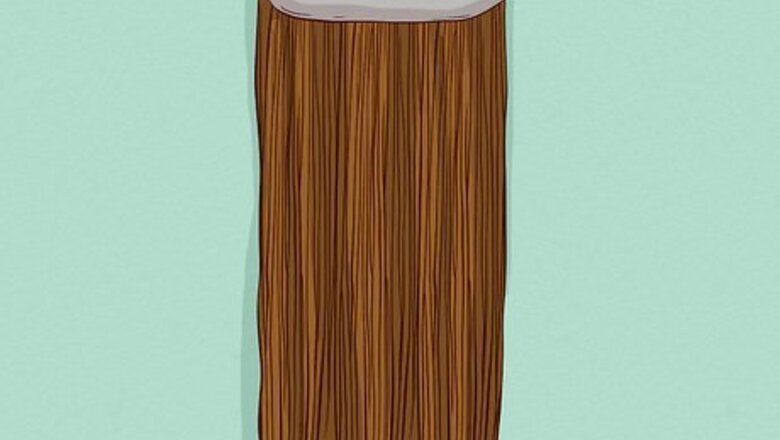
views
Preparing Your Hair

Choose extensions made from human hair. Synthetic hair looks unnaturally shiny and won't blend as well into your natural hair color, so it's best to opt for extensions made from 100% human hair. If you can find them, choose extensions that match your hair's natural texture In addition to not looking as good, synthetic hair can actually cause a serious allergic reaction in some people. With extensions, you get what you pay for. You don’t have to spend a fortune, but you’ll get a more natural result if you save up for higher-quality wefts. Human hair extensions will also last longer than synthetic hair extensions.

Select white bonding glue for lighter hair or black glue for dark hair. Your extensions shouldn’t show through your hair, but they’ll blend more naturally if the glue matches the color of the extensions. Hair bonding glue is generally available in either white or black, so opt for white glue if your hair is light blonde to medium brown, or choose black glue if your hair is dark brown to black. If you’re not sure what type of glue to use, you can ask a sales associate at the same place you buy your extensions. If your hair has different color tones, choose two colors to be sandwiched together to create a more natural or even highlighted look. If you have hair that is differently colored at the root end from the hair ends, then opt for ombre hair extensions that can reflect this range of color change.
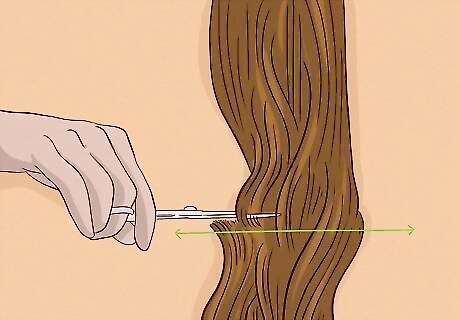
Trim the extensions to the length you want. Hair extensions come in lengths ranging from 8 to 30 inches (20 to 76 cm). If you do want to cut them yourself, hold each weft up to your head at about the spot where you think it will lay, and look in the mirror to determine the length you want. Mark this spot with your fingers, then trim them with sharp scissors. If you’re adding the extensions just for extra volume, cut them to the same length as your hair. If you want to add length, your extensions should be cut longer than your natural hair.
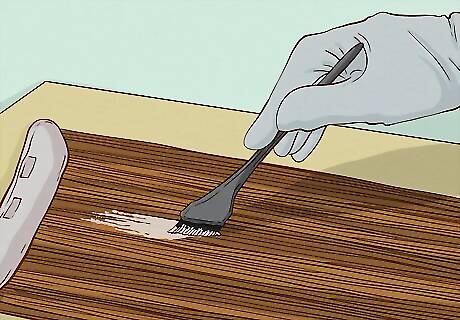
Treat your extensions like your own hair if you color them yourself. You can color extensions made from human hair yourself, but it's best to use semi- or demi-permanent colors because they're not as damaging. Lay them flat and apply the hair color, attempting to match the color to the ends of your hair, rather than the roots. If you want your extensions to look really believable, take them to your hair stylist and have them cut and colored professionally. Do not attempt to dye synthetic hair extensions, as they can be ruined.

Wash, deep condition, and dry your hair before applying the track. The hair bonding glue will adhere better to your hair if it’s free from any oils, so be sure to shampoo your hair thoroughly. In addition, your natural hair will be hidden under the extensions for as long as you have them in. Deep conditioning your hair in advance will help your locks stay nourished and healthy. Your hair should be completely dry before you apply extensions, so either blow dry it or allow it to air dry. Other than shampoo and conditioner, do not use other hair care products before attaching extensions.
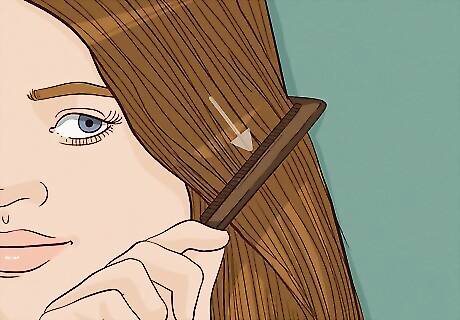
Gently detangle your hair and the extensions with a comb. You’ll get a more even application if the extensions lie straight on your hair, so be sure both your hair and the weft are free of tangles. The extensions are made to be treated like real hair, so although you should be gentle, it’s okay to comb them the same way you would your natural hair. It may help to lay the extensions flat while you’re detangling them. If you have curly hair, it may be easier to detangle your hair before you dry it.
Attaching the Extensions
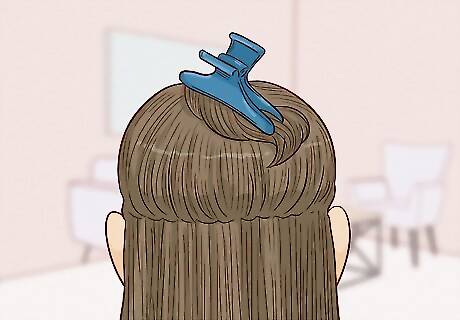
Section the top part of your hair and clip it up. Use a rat-tail comb to draw a line on either side of your part, from your hairline all the way back to your crown. This should create a rectangular section of hair around your part. Pin this section up with clips or a hair tie. If you part your hair in the middle, the section should be at the center of your scalp. If you prefer a side part, the section should be off-center.
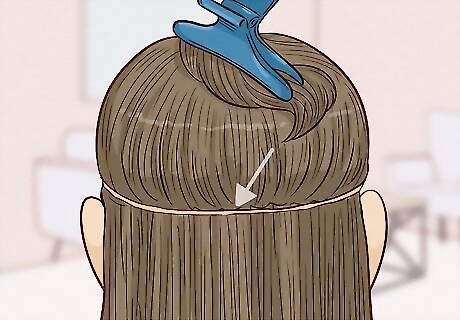
Use your comb to create a U-shaped part above the nape of your neck. Start a little below one of your ears, then follow the natural contour of your head in a U-shape around to your other ear. Leave about 2–3 in (5.1–7.6 cm) Make the part as clean as possible, because you don't want stray hairs getting into your glue.
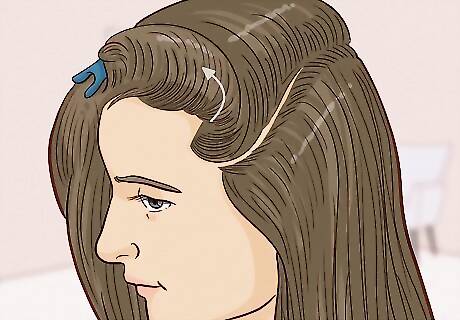
Pull the hair above the part up and clip it out of the way. You should be left with a section of hair 2–3 in (5.1–7.6 cm) above the nape of your neck and stretching from ear to ear. This piece of hair will hide your extensions in the back when you pull your hair up into a ponytail. You’ll need to undo the rest of your hair after you apply the first track, so it’s best to hold the hair up using a banana clip or a similar technique that’s easy to remove.

Cut the track the width of the part you just created. Hold the weft against your scalp about ⁄2 in (1.3 cm) away from your hairline, then stretch it to the other side to ⁄2 in (1.3 cm) away from your hairline. Use your thumb to mark the place where your extension should end as you pull the weft away from your head. Cut the weft with scissors, then hold the extension piece up to double-check the width. You want to leave the extensions at least ⁄2 in (1.3 cm) from your hairline because the piece of hair that’s left will hide the extensions if you pull your hair back.
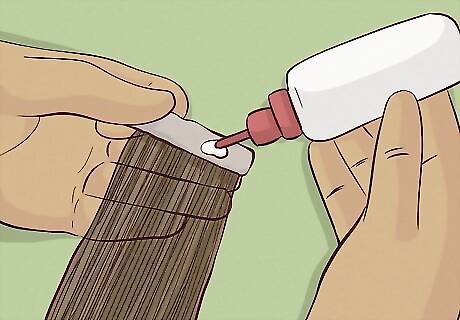
Lay the track flat on a table and apply a line of glue all the way down. The side of the track with the hair attached should be face-down. Apply the glue in small increments until the entire track is covered. There should be enough glue to coat the weft but not drip off.
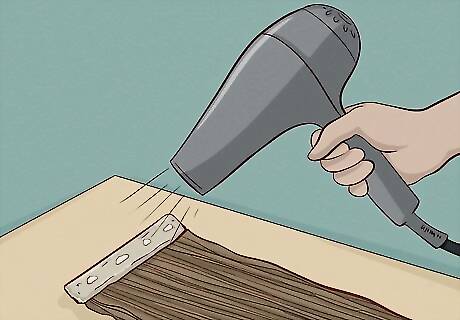
Blow dry the glue on high or medium for several seconds. This will help the glue become tacky so it will adhere to your hair. If the glue is too wet when you apply the extension, the glue will drip down the strands of hair, causing a messier application. Touch the glue to make sure it's neither runny nor dry. It should be about 60-70% dry when you’re finished drying it. Some hair stylists will also apply a strong hold hairspray at this stage and then blow dry your hair. If you're using synthetic hair, make sure your blowdryer is on the cool setting.
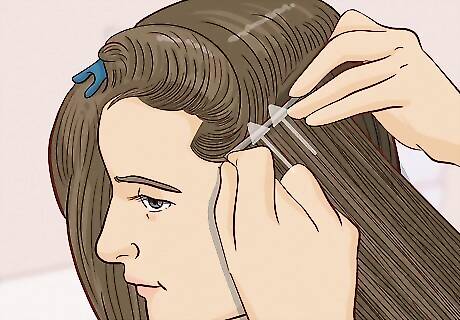
Press the extension onto your hair about ⁄2 in (1.3 cm) from the root. The line of the track should run slightly below the part you made near the nape of your neck. The extension should be installed on an angle. Remember to leave the hair at least ⁄2 in (1.3 cm) away from your hairline. You always need to have enough hair in the front to cover the extensions. Do not apply glue on your scalp. If you apply the extension directly to your scalp, it can stunt the growth of your hair and lead to hair damage. If you find that your extension wasn’t cut long enough, just snip a little piece and apply it using the same method.

Blow dry the track again for another 30-60 seconds. This will finish drying the glue so the extension will stay attached to your hair. To check whether the glue is dry, gently tug on the extensions. If they move, continue drying them. If you opted for synthetic extensions, you may want to use the cool setting on your hair dryer. It's a good idea to use a heat-protecting product before applying heat to your hair and extensions. Treat your extensions like real hair.

Draw a part 2–3 in (5.1–7.6 cm) above the first one and apply another track. The width of your sections can vary based on how thick you want your extensions to be. If you’re primarily hoping to add volume, space them so they’re a little closer. Use the same technique to apply the second extension as you did the first.

Continue adding extensions this way until you reach your ears. Once your part falls above your ears, your U-shape will start near your temple, then will reach back towards your crown and circle around towards your other temple. You’ll still follow the same application technique, but your extensions will be a little longer since they’re reaching further around. This wide U-shape will mimic the natural fall of your hair and should make the finished result look more natural. Place your last extension around the rectangular shape you made at the beginning of the process.
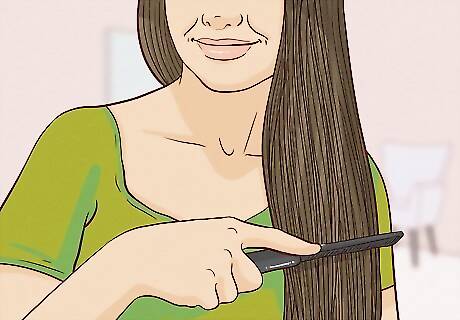
Unclip the top section of hair and gently comb it down. This top section of your hair should completely hide your extensions, so you’re ready to enjoy your glamorous new look! When you're combing out your hair, be sure not to push the comb into your extensions. Gently comb just along the surface of the hair to smooth it out.
Caring for Your Extensions

Treat your extensions the way you would your real hair. Shampooing your extensions can loosen them up, so you may want to hold off on shampooing your hair until you are ready for the extensions to come out. You should brush or comb them regularly, but be careful when you’re combing your hair. Do not place the comb directly onto the glue or you may pull out your extensions, and maybe even some of your own hair. You can heat style extensions made from real hair, although you should limit how much you do so, or your extensions may start to look damaged and messy. Just like with your regular hair, you can spray your extensions with a heat protectant to help prevent damage due to styling.

Keep oil away from your scalp. Don’t apply conditioner directly on your roots, and avoid putting hair oil near your extensions. Oil will dissolve the glue, making your extensions fall out before you’re ready.
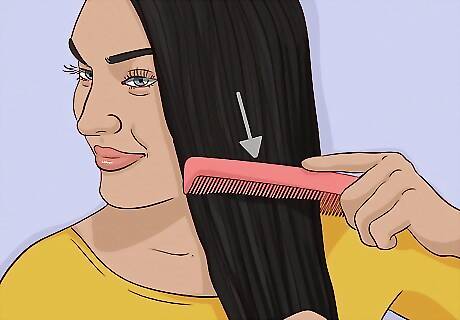
Don't neglect your real hair. Since your natural hair is hidden by your weave, it can be easy to forget about it. However, your hair may become matted or break off if you don't take care of it. Make sure to wash, condition, and detangle your real hair while you’re caring for your extensions. To detangle your real hair, gently lift the extension and comb out the shorter pieces of your own hair.
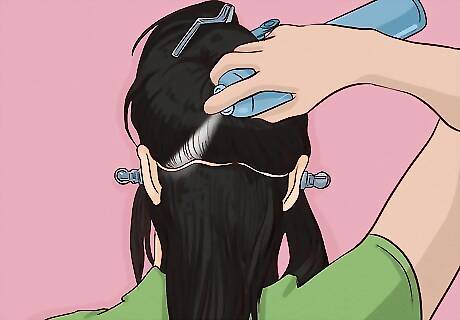
Apply an oil-based solvent when you want to take out the extensions. Saturate your scalp and the bonded wefts thoroughly with scalp oil or silicone spray so the glue completely softens. You can then gently slide the wefts off of your real hair. If there is any glue residue left on your hair and scalp, apply the solvent to a fine-toothed comb and use it to gently remove the glue. You should usually take out your extensions after about 3 weeks, but if you’re experiencing scalp pain or excess shedding, take them out sooner.

Wait a week or two before you apply new extensions. Overuse of extensions can cause loss of hair due to the pulling and extra weight on the hair strand. Give your hair a break once you take out the extensions.




















Comments
0 comment